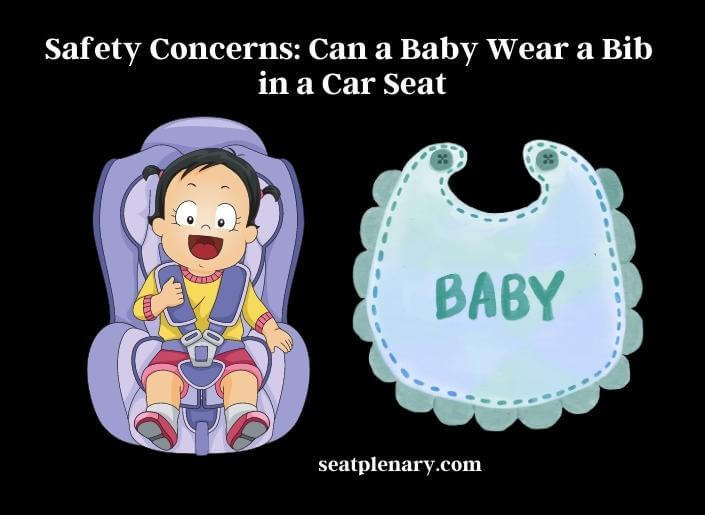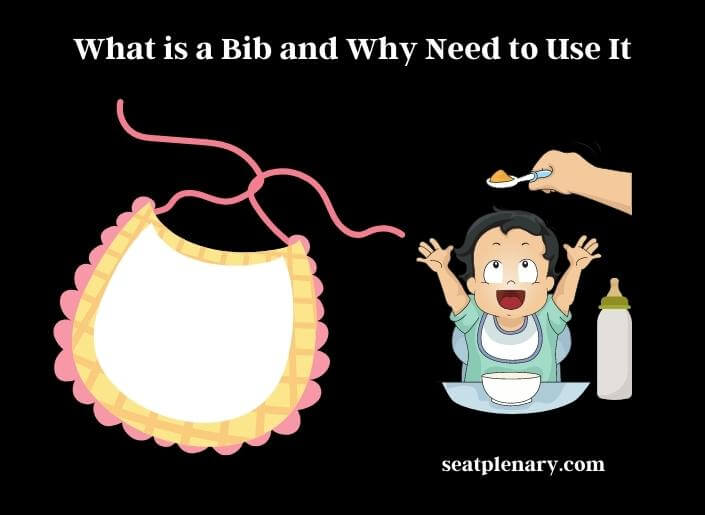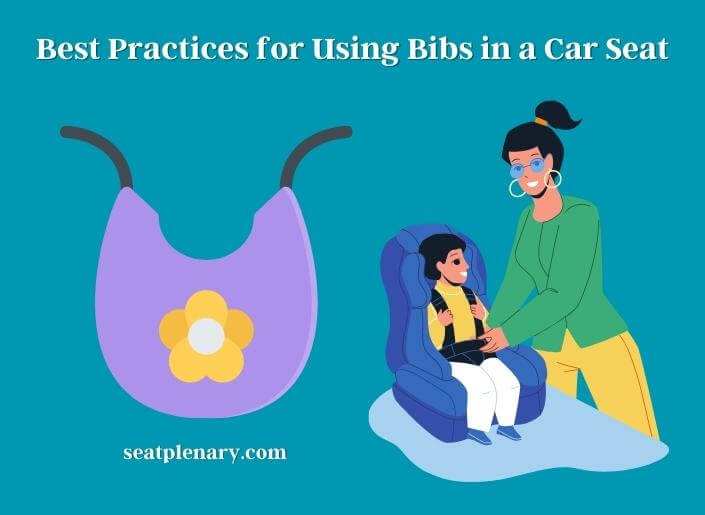Bibs are essential to a baby’s wardrobe and can protect from food and drink spills. But is it safe for your baby to wear a bib in a car seat? The answer is yes, as long as the bib is adequately secured and fits correctly.
It is important to remember that bibs can interfere with the harness straps of the car seat and make it difficult for the straps to fit snugly, so make sure the bib is tucked away and not in the way of the straps. Ensure the bib is made from breathable material so your baby can stay comfortable.

As parents, safety is always a top priority for our children. Knowing the safety concerns associated with using bibs in a car seat is crucial to ensure the well-being of our little ones.
We will explore why bibs pose a risk in car seats and provide alternative solutions to keep your baby clean and safe during car rides. So, buckle up, and let’s jump into this important topic together with the help of subject matter experts in child safety.
What is a Bib and Why Need to Use It?
A bib is worn around a baby’s neck and chest to protect their clothes from getting dirty during feeding. Bibs can be helpful in many situations, some parents wonder whether their use in a car seat is safe.
Bibs come in a variety of sizes, shapes, and materials. Some bibs have sleeves or covers that provide additional protection for clothing, others are designed to be disposable for easy cleanup.

A bib helps keep a baby’s clothes clean and dry during feeding. This can save parents time and money on laundry and prevent the need for frequent clothing changes. Bibs can help avoid skin irritation and rashes caused by food or saliva.
Can Your Baby Wear a Bib in a Car Seat?
Parents often wonder if it’s safe for their baby to wear a bib riding in a car seat. Bibs can help keep a baby’s clothes clean during feeding, but they can also pose safety risks when used in a car seat. Bibs can interfere with the proper fit of the car seat harness, which can compromise the car seat’s effectiveness in the event of an accident.
Bibs can become tangled in the saddle or cause a choking hazard if not properly secured. Parents need to follow safety guidelines when using bibs in car seats to ensure the safety of their children during traveling.
How Does it Affect Car Seat Safety?
Bibs can affect car seat safety in several ways.
Bibs can interfere with the proper fit of the car seat harness, designed to secure the child in the car seat and protect them in the event of an accident. A bib can create space between the harness and the child’s body, reducing the effectiveness of the saddle and increasing the risk of injury in a crash.

Bibs can become tangled in the car seat harness, compromising the child’s safety. Bibs can cause a choking hazard in some cases if they are not adequately secured, twisted, or tangled during use.
For these reasons, parents should follow safety guidelines when using bibs in car seats. This may include choosing bibs with snap or Velcro closures instead of ties, placing the bib over the harness straps instead of under them, and removing the bib once feeding is complete. By taking these precautions, parents can help ensure their child’s safety during traveling in a car seat.
Safety Concerns with Using Bibs in a Car Seat
Using thick and bulky bibs in a car seat can pose safety concerns for young children. Here are some of the reasons why:
1. Interference With Harness Fit:
Thick and bulky bibs can interfere with the proper fit of the car seat harness, designed to secure the child in the car seat and protect them in the event of an accident. The bib can create space between the harness and the child’s body, reducing the effectiveness of the saddle and increasing the risk of injury in a crash.
2. Tangled Bibs:
These types of bibs can become tangled in the car seat harness, compromising the child’s safety. In some cases, bibs can even cause a choking hazard if they are improperly secured, twisted, or tangled during use.
3. Discomfort:
Thick and bulky bibs can be uncomfortable for a child, especially during long car rides. This can cause the child to become fussy or agitated, which can be distracting for the driver.
To ensure the safety of a child riding in a car seat, it’s recommended that parents use thin, lightweight bibs that won’t interfere with the proper fit of the harness. Parents should also make sure that the bib is placed over the harness straps instead of under them and that it doesn’t interfere with the tightness of the harness. By taking these precautions, parents can help ensure their child’s safety by using a bib in a car seat.
What Parents Should Consider Before Putting a Bib on Their Child
Before putting a bib on their child, parents should consider several factors to ensure the safety and comfort of their child:
Age and Development:
Parents should consider the age and development of their children before using a bib. Babies not yet sitting up independently may not need a bib during feeding, older children may benefit from using a bib to protect their clothing from spills and stains.
Material:
Parents should choose bibs made from soft, lightweight fabrics that won’t irritate their child’s skin or interfere with the proper fit of the car seat harness. Bibs from absorbent materials like cotton or terry cloth can help keep a child’s clothes clean and dry during feeding.
Size and Fit:
Parents should choose appropriately sized bibs for their child that fit snugly around the neck without being too tight. Bibs that are too big or small can be uncomfortable for a child and may not provide adequate protection from spills and stains.
Safety Considerations:
Parents should be aware of the safety risks associated with using bibs in a car seat, such as interference with the proper harness fit or the threat of choking. They should follow safety guidelines when using bibs in a car seat to ensure their child’s safe travel.
Best Practices for Using Bibs in a Car Seat
When using a bib in a car seat, these best practices to ensure the safety and comfort of their child:

Choose the Right Bib:
Select a bib made from lightweight, soft materials that won’t interfere with the proper fit of the car seat harness. Avoid using thick or bulky bibs that can create gaps between the harness and the child’s body, compromising their safety.
Place the Bib Correctly:
It should be placed over the car seat harness straps, not under them. This ensures that the harness fits properly against the child’s body without any added bulk or interference from the bib.
Ensure a Proper Fit:
The bib should fit snugly around the child’s neck without being too tight. Make sure the bib doesn’t bunch up or interfere with the tightness of the car seat harness.
Monitor Your Child:
Check the bib frequently to ensure it hasn’t tangled or twisted around the harness straps. Watch your child for discomfort or agitation during long car rides, and adjust the bib as needed.
Parents could help ensure their child’s safety and comfort by using a bib in a car seat. Remember that the most important consideration is always the child’s safety. If there is any doubt about using a bib in a car seat, it’s best to err on caution and avoid using a bib altogether.
Last Point
Using a bib in a car seat can be convenient, choosing the right type of bib is substantial to ensure maximum safety for your little one. Thin and lightweight bibs are generally considered safe in a car seat, thick and bulky bibs should be avoided as they can compromise the proper.
It’s important to know that the Cadillac CTS-V is a performance-oriented version of the Cadillac CTS, a luxury midsize sedan.
Relevant Resources:
